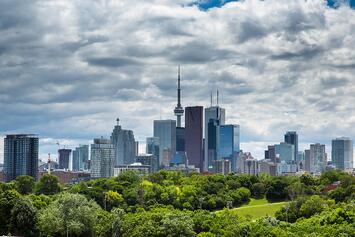
The Ford government’s plan to expand the land supply available for housing has evoked the usual dog whistles about “urban sprawl” by interests apparently unaware of the strong connections between an organically expanding city, housing affordability and upward mobility.
The reality is that the Toronto population centre — its built-up urban area — is already the densest in either Canada or the United States, at 3,100 people per square kilometre. It is about 15 per cent denser than Vancouver or Montreal and about the same density as the built-up urban areas of the European Union. Most people will be surprised to learn, however, that Toronto’s population centre covers only one-third of the Toronto CMA (or Census Metropolitan Area), most of which is in fact rural.
Everyone agrees the Toronto CMA is experiencing a severe housing crisis. Expanding the supply of land available for housing is crucial to ending the crisis. Restricted land supply has made it far more difficult for middle-income households to buy the housing they prefer. Many households have been forced to seek subsidized housing, for which waiting time in Ontario can be over ten years and reach as high as 37 years in the city of Toronto. It’s clear the crisis in housing affordability crisis has reduced standards of living and increased poverty.
The problem has been worsening since the middle 2000s, when the government of Dalton McGuinty enacted the “Places to Grow” program, with its greenbelt banning housing construction just outside the edge of existing development. This made the land market for housing much less competitive even as strong demand for housing continued. Not surprisingly, housing affordability began to deteriorate in the Toronto CMA. In 2004, the median-priced house was about four times the pre-tax median household income (a ratio called the “median multiple”). By 2021, the median price had risen to over 10 times median income.
There is no mystery here. International research shows that policies of urban containment, such as greenbelts and growth boundaries, are associated with large price increases. The eight-nation Demographia International Housing Affordability Survey that I have been publishing for 18 years showed, in the last pre-pandemic year (2019), that all markets with severely unaffordable housing had urban containment policies.
The cost of actually building a house does not vary that much across Canada. The Altus Group’s surveys show Toronto construction costs to be about one-third higher than Winnipeg’s. Yet houses in Toronto cost more than 250 per cent more than those in Winnipeg, with much of the difference being due to land and land-related costs. As the numbers suggest, Winnipeg does not engage in market-distorting urban containment.
Read the rest of this piece at Financial Post.
Wendell Cox is a senior fellow at the Frontier Centre for Public Policy (Winnipeg) and author of Demographia International Housing Affordability Index. He is also a contributing editor of newgeography.com."
Photo: Simon Carr via Wikimedia CC 2.0 License.












